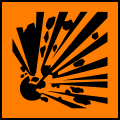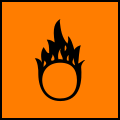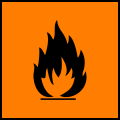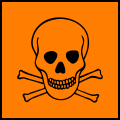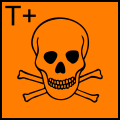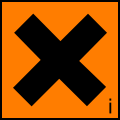Hazard symbol facts for kids
Hazard symbols are special pictures or signs that warn people about dangers. They are usually pictograms, which are small drawings that quickly show you what might happen or what you should do. These symbols help keep people safe by making it easy to understand risks, even if you don't speak the local language.
European Chemical Hazard Symbols
The European Union uses a set of special symbols to warn people about dangers from chemicals. These are called hazard symbols for chemicals. They help everyone know if a chemical is dangerous, like if it can explode or cause harm.
-
Explosive (E)
This symbol means the chemical can explode. An example is Trinitrotoluene. -
Oxidizing agent (O)
This chemical helps fires burn hotter and faster. An example is Oxygen. -
Highly flammable (F)
This chemical can easily catch fire. An example is Ethanol. -
Extremely flammable (F+)
This chemical can catch fire very, very easily. An example is Hydrogen. -
Toxic (T)
This chemical is a poison and can be harmful if swallowed or touched. Examples include Barium chloride and many acids. -
Very toxic (T+)
This chemical is an even stronger poison and is extremely dangerous. An example is Nicotine. -
Irritant (Xi)
This chemical can irritate or damage your skin or eyes. Examples include Fumaric acid and bleach. -
Corrosive (C)
This chemical can burn or destroy living tissue, like your skin or eyes. An example is Hydrochloric acid. -
Dangerous for the environment (N)
This chemical can harm plants, animals, or the environment if it gets into nature. An example is Lindane.
The letter "n" in the "Harmful" symbol (Xn) comes from French and Italian words that mean "harmful" or "noxious."
Images for kids
-
This sign warns of high voltage and danger of death on a fence around the Beromünster Reserve Broadcasting Tower in Switzerland.
See also
 In Spanish: Símbolo de riesgo químico para niños
In Spanish: Símbolo de riesgo químico para niños


